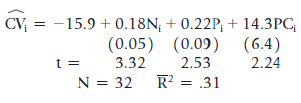Lets return to the analysis of the international pharmaceutical industry that we started in Exercise 9 of
Question:
Let’s return to the analysis of the international pharmaceutical industry that we started in Exercise 9 of Chapter 5. That study was cross sectional and included countries as large as the United States and as small as Luxembourg, so you’d certainly expect heteroskedasticity to be a potential problem. Luckily, the dependent variable in the original research was Pi, the pharmaceutical price level in the ith country divided by that of the United States, so the researchers didn’t encounter the wide variations in size typically associated with heteroskedasticity. (Do you see why?)
Suppose, however, that we use the same data set to build a model of pharmaceutical consumption:
Where:
CVi = the volume of consumption of pharmaceuticals in the ith country divided by that of the United States
Ni = the population of the ith country divided by that of the United States
PCi = a dummy variable equal to 1 if the ith country encouraged price competition, 0 otherwise
a. Does heteroskedasticity seem more likely when CV is the dependent variable than when P is the dependent variable? Explain your reasoning.
b. Use the data in Table 5.2 (datafile = DRUGS5) to test for heteroskedasticity in Equation 10.21 with both the Breusch–Pagan and the White test at the 5-percent level.
c. If your answer to part b is heteroskedasticity, estimate HC standard errors for Equation 10.21.
d. Similarly, if you encountered heteroskedasticity, re-estimate Equation 10.21 using a double-log functional form.
e. Similarly, if you encountered heteroskedasticity, reformulate the variables in Equation 10.21 to avoid heteroskedasticity and estimate your reformulated equation.
f. Which of our three remedies for heteroskedasticity do you think is best in this case? Why?
g. In Chapter 5, we estimated an equation with P as a function of CVN (CV per capita), and now we’ve estimated an equation with CV as a function of PC. Which Classical Assumption are you worried that we might have violated? Explain.
Step by Step Answer:








